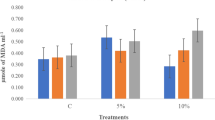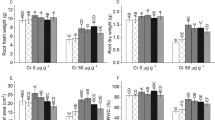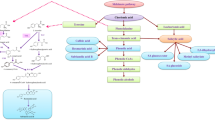Abstract
Seed priming increases tolerance of plants against various environmental stresses. Although ample literature is available that depicts the beneficial effects of priming under different environmental stresses, the information on induction of tolerance to Pb stress through seed priming with ascorbic acid (AsA) is limited. Therefore, this study was performed to examine the effect of seed priming with AsA (50 and 100 mg L−1), hydropriming and without priming (control) on physiochemical processes of okra cultivars (Subz-Pari and Arka Anamika) under Pb stress (0, 100 mg L−1). Pb stress caused a considerable decline in plant growth and photosynthetic pigments. Contrarily, Pb stress exhibited rise in the contents of total amino acids, free proline, total soluble proteins and AsA. The POD, CAT, and SOD activities were recorded highest at 100 mg L−1 of Pb. Moreover, Pb stress markedly increased H2O2 and MDA levels that triggered oxidative stress. However, plants raised from seed primed with AsA and water exhibited better growth and had higher chlorophylls, free proline, total proteins, total amino acids, AsA and activities of enzymatic antioxidants. Priming with AsA (50 mg L−1) induced better tolerance to Pb stress in okra plants. Plants of cv. Arka Anamika exhibited greater tolerance to Pb than that of cv. Subz-Pari as was evident from higher plant fresh and dry masses.




Similar content being viewed by others
References
Agrawal SB, Singh A, Sharma RK, Agrawal M (2007) Bioaccumulation of heavy metal in leafy vegetables: a threat to human health. Terr Aquat Environ Toxicol 1(2):13–23
Akinyele BO, Temikotan T (2007) Effect of variation in soil texture on the vegetative and pod characteristics of okra (Abelmoschus esculentus (L.) Moench). Intr J Agric Res 2:165–169
Akram NA, Shafiq F, Ashraf M (2017) Ascorbic acid—a potential oxidant scavenger and its role in plant development and abiotic stress tolerance. Front Plant Sci 8:613. doi:10.3389/fpls.2017.00613
Al Jassir MS, Shaker A, Khaliq MA (2005) Deposition of heavy metals on green leafy vegetables sold on roadsides of Riyadh city, Saudi Arabia. Bull Environ Contam Toxicol 75(5):1020–1027. doi:10.1007/s00128-005-0851-4
Ali B, Mwamba TM, Gill RA, Yang C, Ali S, Daud MK, Wu Y, Zhou W (2014) Improvement of element uptake and antioxidative defense in Brassica napus under lead stress by application of hydrogen sulfide. Plant Growth Regul 74(3):261–273. doi:10.1007/s10725-014-9917-9
Alscher RG, Erturk N, Heath LS (2002) Role of superoxide dismutases (SODs) in controlling oxidative stress in plants. J Exp Bot 53(372):1331–1341. doi:10.1093/jexbot/53.372.1331
Anwar F, Rashid U, Ashraf M, Nadeem M (2010) Okra (Hibiscus esculentus) seed oil for biodiesel production. Appl Energ 87(3):779–785. doi:10.1016/j.apenergy.2009.09.020
Ashraf M, Foolad M (2007) Roles of glycine betaine and proline in improving plant abiotic stress resistance. Environ Exp Bot 59(2):206–216. doi:10.1016/j.envexpbot.2005.12.006
Ashraf MA, Ashraf M, Shahbaz M (2012) Growth stage-based modulation in antioxidant defense system and proline accumulation in two hexaploid wheat (Triticum aestivum L.) cultivars differing in salinity tolerance. Flora 207(5):388–397. doi:10.1016/j.flora.2012.03.004
Athar HUR, Khan A, Ashraf M (2009) Inducing salt tolerance in wheat by exogenously applied ascorbic acid through different modes. J Plant Nutr 32(11):1799–1817. doi:10.1080/01904160903242334
Avci H (2013) Heavy metals in vegetables irrigated with wastewaters in Gaziantep, Turkey: a review of causes and potential for human health risks. Fresenius Environ Bull 22(1):146–151
Azmat R, Akhtar H (2010) Changes in some biophysical and biochemical parameters of mungbean [Vigna radiata (L.) wilczek] grown on chromium-contaminated soils treated with solid tea wastage. Pak J Bot 42(5):3065–3071
Azmat R, Khan N (2011) Nitrogen metabolism as a bioindicator of Cu stress in Vigna radiata. Pak J Bot 43(1):515–520
Barth C, De Tullio M, Conklin PL (2006) The role of ascorbic acid in the control of flowering time and the onset of senescence. J Exp Bot 57(8):1657–1665. doi:10.1093/jxb/erj198
Bates IS, Waldren RP, Teare ID (1973) Rapid determination of free proline for water stress studies. Plant Soil 39:205–207. doi:10.1007/BF00018060
Bhardwaj P, Chaturvedi AK, Prasad P (2009) Effect of enhanced lead and cadmium in soil on physiological and biochemical attributes of Phaseolus vulgaris, L. Nat Sci 7(8):63–75
Birben E, Sahiner UM, Sackesen C, Erzurum S, Kalayci O (2012) Oxidative stress and antioxidant defense. World Allergy Organ J 5(1):9–19. doi:10.1097/WOX.0b013e3182439613
Bradford MM (1976) A rapid and sensitive method for the quantitation of microgram quantities of protein utilizing the principle of protein–dye binding. Ann Biochem 72:248–254. doi:10.1016/0003-2697(76)90527-3
Bybordi A (2012) Effect of AsA and siliciun on photosynthesis, antioxidant enzyme activity, and fatty acid contents in canola exposure to salt stress. J Integr Agric 11(10):1610–1620. doi:10.1016/S2095-3119(12)60164-6
Cakmark I, Strboe D, Marschner H (1993) Activities of hydrogen peroxide scavenging enzymes in germinating wheat seeds. J Exp Bot 44:127–132. doi:10.1093/jxb/44.1.127
Cvikrová M, Gemperlová L, Dobrá J, Martincová O, Prásil IT, Gubis J et al (2012) Effect of heat stress on polyamine metabolism in proline-over-producing tobacco plants. Plant Biol 182:49–58. doi:10.1016/j.plantsci.2011.01.016
Davies BH (1976) Carotenoids. In: Goodwin TW (ed) Chemistry and Biochemistry of Plant Pigments. Academic Press, London, pp 138–165
Dilruba S, Hasanuzzaman M, Karim R, Nahar K (2009) Yield response of okra to different sowing time and application of growth hormones. J Hortic Sci Ornam Plants 1(1):10–14
Dolatabadian A, Modarres Sanavy SAM, Sharifi M (2009) Alleviation of water deficit stress effects by foliar application of AsA on Zea mays L. J Agron Crop Sci 195(5):347–355. doi:10.1111/j.1439-037X.2009.00382.x
Ebrahimian E, Bybordi A (2012) Influence of ascorbic acid foliar application on chlorophyll, flavonoids, anthocyanin and soluble sugar contents of sunflower under conditions of water deficit stress. J Food Agric Environ 10:1026–1030
Gallie DR (2013) l-ascorbic acid: a multifunctional molecule supporting plant growth and development. Sci (Cairo) 2013:795964. doi:10.1155/2013/795964
Gautam RK, Sharma SK, Mahiya S, Chattopadhyaya MC (2014) Contamination of heavy metals in aquatic media: transport, toxicity and technologies for remediation. In: Heavy metals, in water: presence, removal and safety, pp 1–24. doi:10.1039/9781782620174-00001
Gemede HF, Ratta N, Haki GD, Woldegiorgis AZ, Beyene F (2015) Nutritional quality and health benefits of okra (Abelmoschus esculentus): a review. Food Process Technol 6(6):458. doi:10.4172/2157-7110.1000458
Gill SS, Tuteja N (2010) Reactive oxygen species and antioxidant machinery in abiotic stress tolerance in crop plants. Plant Physiol Biochem 48(12):909–930. doi:10.1016/j.plaphy.2010.08.016
Gong H, Zhu X, Chen K, Wang S, Zhang C (2005) Silicon alleviates oxidative damage of wheat plants in pots under drought. Plant Sci 169:313–321. doi:10.1016/j.plantsci.2005.02.023
Gopal R, Rizvi AH (2008) Excess lead alters growth, metabolism and translocation of certain nutrients in radish. Chemosphere 70(9):1539–1544. doi:10.1016/j.chemosphere.2007.08.043
Green M, Prof SF (2005) Apoplastic degradation of ascorbate: novel enzymes and metabolites permeating the plant cell wall. Plant Biosyst 139:2–7. doi:10.1080/11263500500056849
Gul H, Ahmad R, Hamayun M (2015) Impact of exogenously applied AsA on growth, some biochemical constituents and ionic composition of guar (Cymopsis Tetragonoloba) subjected to salinity stress. Pakhtunkhwa J Life Sci 3(01–02):22–40
Gupta DK, Nicoloso FT, Schetinger MRC, Rossato LV, Pereira LB, Castro GY, Srivastava S, Tripathi RD (2009) Antioxidant defense mechanism in hydroponically grown Zea mays seedlings under moderate lead stress. J Hazard Mater 172(1):479–484. doi:10.1016/j.jhazmat.2009.06.14
Haider S, Kanwal S, Uddin F, Azmat R (2006) Phytotoxicity of Pb II. Changes in chlorophyll absorption spectrum due to toxic metal Pb stress on Phaseolus mungo and Lens culinaris. Pak J Biol Sci 9(11):2062–2068
Hamid N, Bukhari N, Jawaid F (2010) Physiological responses of Phaseolus vulgaris to different lead concentrations. Pak J Bot 42(1):239–246
Hameed A, Gulzar S, Aziz I, Hussain T, Gul B, Khan MA (2015) Effects of salinity and ascorbic acid on growth, water status and antioxidant system in a perennial halophyte. AoB Plants 7:plv004. doi:10.1093/aobpla/plv004
Hamilton PB, Van Slyke DD (1973) Amino acid determination and metal accumulation by Brassica juncea L. Int J Plant Prod 3(1):1735–8043
Hayat S, Hayat Q, Alyemeni MN, Wani AS, Pichtel J, Ahmad A (2012) Role of proline under changing environments: a review. Plant Signal Behav 7(11):1456–1466. doi:10.4161/psb.21949
Hemavathi Upadhyaya CP, Akula N, Young KE, Chun SC, Kim DH, Park SW (2010) Enhanced ascorbic acid accumulation in transgenic potato confers tolerance to various abiotic stresses. Biotechnol Lett 32:321–330. doi:10.1007/s10529-009-0140-0
Hodges DM, Nozzolillo C (1996) Anthocyanin and anthocyanoplast content of cruciferous seedlings subjected to mineral nutrient deficiencies. J Plant Physiol 147(6):749–754. doi:10.1016/S0176-1617(11)81488-4
Hodges DM, DeLong JM, Forney CF, Prange RK (1999) Improving the thiobarbituric acid-reactive-substances assay for estimating lipid peroxidation in plant tissues containing anthocyanin and other interfering compounds. Planta 207:604–611. doi:10.1007/s004250050524
Ip CCM, Li XD, Zhang G, Wong CSC, Zhang WL (2005) Heavy metal and Pb isotopic compositions of aquatic organisms in the Pearl River Estuary, South China. Environ Pollut 138(3):494–504. doi:10.1016/j.envpol.2005.04.016
Iqbal M, Hussain I, Liaqat H, Ashraf MA, Rasheed R, Rehman AU (2015) Exogenously applied selenium reduces oxidative stress and induces heat tolerance in spring wheat. Plant Physiol Biochem 94:95–103
Islam E, Liu D, Li TQ, Yang X, Jin XF, Mahmooda Q, Tian S, Li JY (2008) Effect of Pb toxicity on leaf growth, physiology and ultrastructure in the two ecotypes of Elsholtzia argyi. J Hazard Mater 154(1):914–926. doi:10.1016/j.jhazmat.2007.10.121
Järup L (2003) Hazards of heavy metal contamination. Br Med Bull 68(1):167–182. doi:10.1093/bmb/ldg032
Khan T, Mazid M, Mohammad F (2011) A review of ascorbic acid potentialities against oxidative stress induced in plants. J Agrobiol 28(2):97–111. doi:10.2478/v10146-011-0011-x
Khan I, Iqbal M, Ashraf MY, Ashraf MA, Ali S (2016) Organic chelants-mediated enhanced lead (Pb) uptake and accumulation is associated with higher activity of enzymatic antioxidants in spinach (Spinacea oleracea L.). J Hazard Mater 317:352–361
Kirkham MB (2006) Cadmium in plants on polluted soils: effects of soil factors, hyperaccumulation, and amendments. Geoderma 137(1):19–32. doi:10.1016/j.geothermal.2006.08.024
Kitamura Y, Ohta M, Ikenaga T, Watanabe M (2002) Responses of anthocyanin-producing and non-producing cells of Glehnia littoralis to radical generators. Phytochemistry 59(1):63–68. doi:10.1016/S0031-9422(01)00428-9
Kostopoulou Z, Therios I, Roumeliotis E, Kanellis AK, Molassiotis A (2015) Melatonin combined with ascorbic acid provides salt adaptation in Citrus aurantium L. seedlings. Plant Physiol Biochem 86:155–165. doi:10.1016/j.plaphy.2014.11.021
Krivosheeva A, Tao DL, Ottander C, Wingsle G, Dube SL, Oquist G (1996) Cold acclimation and photoinhibition of photosynthesis in Scots pine. Planta 200:296–305. doi:10.1007/BF00200296
Kumar A, Prasad MNV (2015) Lead-induced toxicity and interference in chlorophyll fluorescence in Talinum triangulare grown hydroponically. Photosynthetica 53(1):66–71. doi:10.1007/s11099-015-0091-8
Kumar A, Prasad MNV, Sytar O (2012) Lead toxicity, defense strategies and associated indicative biomarkers in Talinum triangulare grown hydroponically. Chemosphere 89(9):1056–1065. doi:10.1016/j.chemosphere.2012.05.070
Lamhamdi M, El Galiou O, Bakrim A, Nóvoa-Muñoz JC, Arias-Estevez M, Aarab A, Lafont R (2013) Effect of lead stress on mineral content and growth of wheat (Triticum aestivum) and spinach (Spinacia oleracea) seedlings. Saudi J Biol Sci 20(1):29–36. doi:10.1016/j.sjbs.2012.09.001
Lasat MM (2002) Phytoextraction of toxic metals—a review of biological mechanisms. J Environ Qual 31:109–120. doi:10.2134/jeq2002.1090
Li Y, Song Y, Shi G, Wang J, Hou X (2009) Response of antioxidant activity to excess copper in two cultivars of Brassica campestris spp. chinensis Makino. Acta Physiol Plant 31:155–162. doi:10.1007/s11738-008-0216-9
Mahmood S, Parveen A, Hussain I, Javed S, Iqbal M (2014) Possible involvement of secondary metabolites in the thermotolerance of maize seedlings. Int J Agric Biol 16:1075–1082
Mishra S, Srivastava S, Tripathi R, Kumar R, Seth C, Gupta D (2006) Lead detoxification by coontail (Ceratophyllum demersum L.) involves induction of phytochelatins and antioxidant system in response to its accumulation. Chemosphere 65:1027–1039. doi:10.1016/j.chemosphere.2006.03.033
Morelli E, Scarano G (2001) Synthesis and stability of phytochelatins induced by cadmium and lead in the marine diatom Phaeodactylum tricornutum. Mar Environ Res 52(4):383–395. doi:10.1016/S0141-1136(01)00093-9
Mukherjee SP, Choudhuri MA (1983) Implications of water stress-induced changes in the levels of endogenous AsA and hydrogen peroxide in Vigna seedlings. Physiol Plant 58(2):166–170. doi:10.1111/j.1399-3054.1983.tb04162.x
Ndunguru J, Rajabu AC (2004) Effect of okra mosaic virus diseases on the above- ground morphological yield components of okra in Tanzania. Sci Hortic 99:225–235. doi:10.1016/S0304-4238(03)00108-0
Pignocchi C, Foyer CH (2003) Apoplastic ascorbate metabolism and its role in the regulation of cell signaling. Curr Opin Plant Biol 6(4):379–389. doi:10.1016/S1369-5266(03)00069-4
Piotrowska A, Bajguz A, Godlewska B, Czerpak R, Kaminska M (2009) Jasmonic acid as modulator of lead toxicity in aquatic plant Wolffia arrhiza (Lamnaceae). Environ Exp Bot 66:507–513. doi:10.1016/j.envexpbot.2009.03.019
Reddy AM, Kumar SG, Jyothsnakumari G, Thimmanaik S, Sudhakar C (2005) Lead induced changes in antioxidant metabolism of horsegram (Macrotyloma uniflorum (Lam.) Verdc.) and bengalgram (Cicer arietinum L.). Chemosphere 60(1):97–104. doi:10.1016/j.chemosphere.2004.11.092
Sahoo S, Mohanty S, Rout S, Kanungo S (2014) The effect of lead toxicity on growth and antioxidant enzyme expression of Abutilon indicum L. Int J Pharm Pharm Sci 7(2):134–138
Schützendübel A, Nikolova P, Rudolf C, Polle A (2002) Cadmium and H2O2-induced oxidative stress in Populus × canescens roots. Plant Physiol Biochem 40:577–584. doi:10.1016/S0981-9428(02)01411-0
Sêkara A, Poniedzialeek M, Ciura J, Jedrszczyk E (2005) Cadmium and lead accumulation and distribution in the organs of nine crops: implications for phytoremediation. Polish J Environ Stud 14(4):509–516
Shahid MR, Amjad M, Ziaf K, Jahangir MM, Ahmad S, Iqbal Q, Nawaz A (2013) Growth, yield and seed production of okra as influenced by different growth regulators. Pak J Agric Sci 50(3):387–392
Sharma P, Dubey RS (2005) Lead toxicity in plants. Braz J Plant Physiol 17(1):35–52. doi:10.1590/S1677-04202005000100004
Shu X, Yin L, Zhang Q, Wang W (2012) Effect of Pb toxicity on leaf growth, antioxidant enzyme activities, and photosynthesis in cuttings and seedlings of Jatropha curcas L. Environ Sci Pollut Res 19(3):893–902. doi:10.1007/s11356-011-0625-y
Singh A, Sharma RK, Agrawal M, Marshall FM (2010) Health risk assessment of heavy metals via dietary intake of foodstuffs from the wastewater irrigated site of a dry tropical area of India. Food Chem Toxicol 48(2):611–619. doi:10.1016/j.fct.2009.11.041
Smirnoff N (2000) AsA: metabolism and functions of a multi-facetted molecule. Curr Opin Plant Biol 3(3):229–235. doi:10.1016/S1369-5266(00)80070-9
Suzuki N, Koussevitzky S, Mittler RN, Miller GAD (2012) ROS and redox signalling in the response of plants to abiotic stress. Plant Cell Environ 35(2):259–270. doi:10.1111/j.1365-3040.2011.02336.x
Tanyolac D, Ekmekçi Y, Ünalan Ş (2007) Changes in photochemical and antioxidant enzyme activities in maize (Zea mays L.) leaves exposed to excess copper. Chemosphere 67(1):89–98. doi:10.1016/j.chemosphere.2006.09.052
Velikova V, Yordanov I, Edreva A (2000) Oxidative stress and some antioxidant systems in acid rain-treated bean plants: protective roles of exogenous polyamines. Plant Sci 151:59–66. doi:10.1016/S0168-9452(99)00197-1
Venkatesh J, Park SW (2014) Role of l-ascorbate in alleviating abiotic stresses. Bot Stud 55:38. doi:10.1186/1999-3110-55-38
Verma S, Dubey RS (2003) Lead toxicity induces lipid peroxidation and alters the activities of antioxidant enzymes in growing rice plants. Plant Sci 164(4):645–655. doi:10.1016/S0168-9452(03)00022-0
Voskresenskaya OL, Voskresenskiy VS, Alyabysheva EA (2013) Accumulation of heavy metals in soil and plants in location gathering and temporary storage solid waste. Modern Problems Sci Edu. http://www.science-education.ru/108-r8659 (in Russian)
Yoshida S, Forno DA, Cock JH, Gomez KA (1976) Laboratory manual for physiological studies of rice. IRRI, Los Banos, p 61
Zhang Y (2013) AsA in plants: biosynthesis, regulation and enhancement. Springer Science & Business Media, New York
Acknowledgements
This study was partly supported by the Grants from the Punjab Higher Education Commission (PHEC), Lahore, Pakistan.
Author information
Authors and Affiliations
Corresponding author
Ethics declarations
Conflict of interest
The authors declare that they have no conflict of interest.
Additional information
Communicated by N. A. Anjum.
Rights and permissions
About this article
Cite this article
Hussain, I., Siddique, A., Ashraf, M.A. et al. Does exogenous application of ascorbic acid modulate growth, photosynthetic pigments and oxidative defense in okra (Abelmoschus esculentus (L.) Moench) under lead stress?. Acta Physiol Plant 39, 144 (2017). https://doi.org/10.1007/s11738-017-2439-0
Received:
Revised:
Accepted:
Published:
DOI: https://doi.org/10.1007/s11738-017-2439-0




